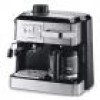DeLonghi BCO330T Owner Manual - Page 12
Descaling - espresso and coffee maker
 |
View all DeLonghi BCO330T manuals
Add to My Manuals
Save this manual to your list of manuals |
Page 12 highlights
en Descaling • Pour the frothed milk slowly over the coffee with the aid of a spoon, then sprinkle a bit of cocoa powder on top for a perfect cappuccino. • To make 4 cappuccinos, repeat the previous steps, paying attention to the quantity of water, milk and ground coffee indicated in the table in the table on page 11. IMPORTANT: The cappuccino nozzle must always be cleaned after each use. Proceed as follows: • Remove the cappuccino nozzle by turning it clockwise (Fig. 26) and wash it thoroughly with warm water (fig. 27). • Check that the three holes indicated in Fig. 28 are not obstructed. Clean if necessary using a pin. • Clean the steam spout, being careful not to burn yourself. • Screw the cappuccino nozzle back on. Cleaning and maintenance • During the cleaning operation, never immerse the ma- chine in water. It is an electrical appliance. • Before carrying out any cleaning of the external parts of the appliance, switch off the machine, remove the plug from the change to electrical outlet and let the machine cool down. • Do not use solvents or abrasive detergents to clean the appliance. A soft damp cloth is sufficient. • Clean the filter-holder, drip tray, boiler outlet, carafe and water tank regularly. Never wash the filter-holder and the other accessories in the dishwasher. • Rinse all the components and clean the espresso filter thoroughly with warm water and a small brush. • From time to time, check to make sure the holes in the espresso filter are not obstructed. If necessary, clean using a pin. Descaling the drip coffee section With time, the limestone content of the water can cause obstructions which may effect the correct functioning of the appliance. It is advisable to carry out descaling of the machine after about every 40 uses. For this descaling procedure, use an appropriate descaler for filter coffee machines, available in the shops. If such a product is not obtainable, the operation can be carried out in the following way: 1. Pour 4 cupfuls of water into the drip coffee carafe; 2. Dissolve 2 spoonfuls (about 30 grams) of citric acid in the water (sold at drug stores or at grocery stores); 3. Place the drip coffee carafe onto on the hot plate; 4. Press the ON/OFF button, percolate the equivalent of a cupful and then switch off the appliance; 5. Leave the solution to act for 15 minutes. Repeat operations 4 and 5 another time. 6. Switch on the machine and continue production until the tank is completely empty. 7. Rinse out by running the appliance just using water at least three times (3 full tanks of water). Descaling the espresso section Over time, heating the water used to make the coffee leads to lime scale buildup in the internal circuits of the appliance. We, therefore, recommend that you descale the espresso maker every 2-6 months (depending on the hardness of the water and the frequency of use), or, in any case, not more than 150 coffees. Proceed as follows: 1. Fill the small espresso carafe with water up to level 4 on the WATER LEVEL side. 2. Dissolve 1 spoonful (about 15-20 grams) of citric acid (sold at drug stores or at grocery stores) in the water. 3. Pour the solution into the boiler and screw on the cap. 4. Make sure the espresso/steam knob is closed and attach the filter-holder. 5. Place the small espresso carafe under the espresso filter holder. 6. After a few minutes, the solution begins to run into the carafe. Every now and then, turn the espresso/steam knob to position to let out a little of the solution from the cappuccino nozzle. 8. When all the solution has run through, turn the appliance off and let it cool down. 9. To eliminate the descaling solution residues, repeat steps 1 to 8 at least twice, using water only (without adding citric acid). 10












